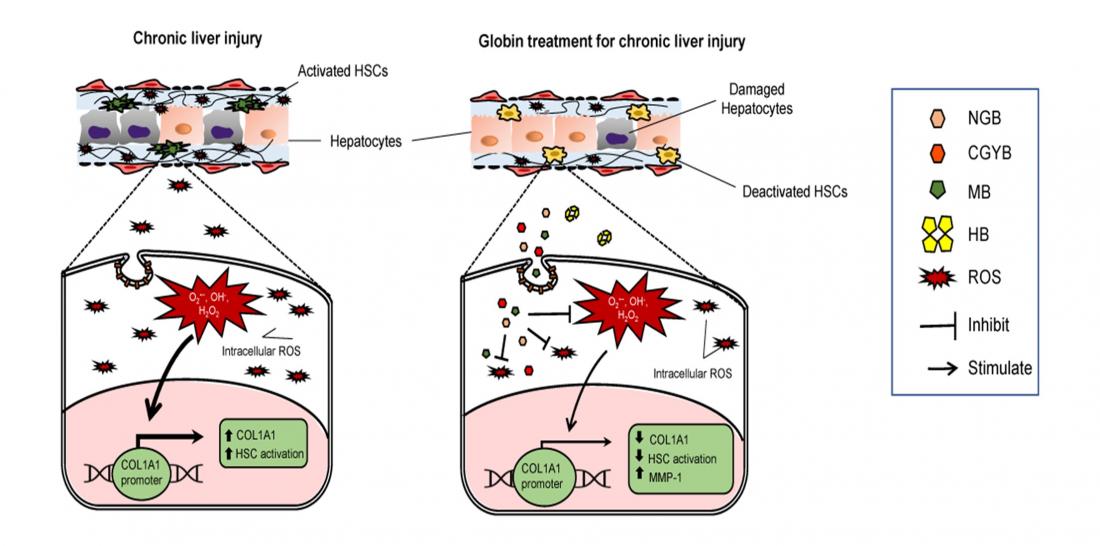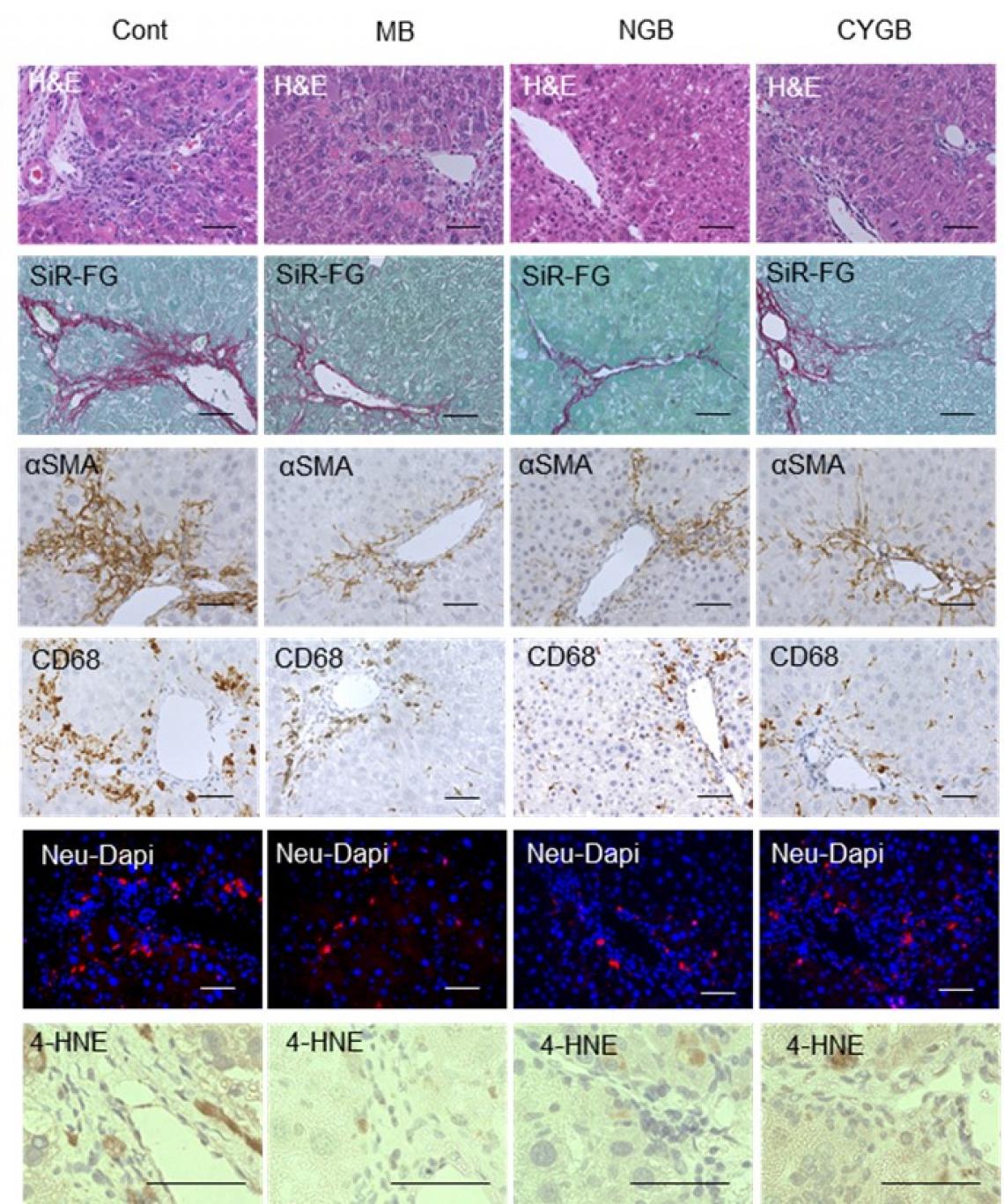MB, NGB, and CYGB, but not HB, were endocytosed into the HSCs via endocytosis pathway, scavenged intracellular ROS, and suppressed COL1A1 promoter activity, resulting in HSC deactivation and inhibition of collagen production in vitro and in vivo. Globin therapy could be utilized as anti-fibrotic therapy in human liver cirrhosis.
Intravenously injected MB, NGB, and CYGB markedly suppressed liver inflammation, fibrosis and oxidative cell damage in fibrotic mice without adverse effects. Cont. untreated control; MB, NGB, CYGB: intravenous administration of MB, NGB, CYGB. H&E, hematoxylin and eosin staining; SiR-FG, Sirius red-fast green staining; SMA, stellate cell activation marker; CD68: macrophage marker; Neu-Dapi, Neutrofil marker – DAPI nuclear staining; 4-HNE, oxidative cell damage marker, 4-hydroxynonenal
Anti-fibrotic therapy remains an unmet medical need in human chronic liver diseases. A research team led by Professor Norifumi Kawada, Osaka City University (OCU), reported the anti-fibrotic function of globin family members in hepatic stellate cells (HSCs), the main cell type involved in liver fibrosis. In mice with advanced liver fibrosis, myoglobin (MB), (neuroglobin) NGB and (cytoglobin) CYGB injection can suppress liver inflammation and fibrosis.
The functions of globin family members have been extensively studied, focusing primarily on the specific tissues in which these proteins are expressed: hemoglobin (HB) in erythrocytes, MB in muscle cells, NGB in nervous tissues, and CYGB in pericytes and fibroblasts. Beyond the well-established oxygen-binding respiratory functions of heme-containing proteins, all globins are also known to be involved in the regulation of harmful reactive oxygen species (ROS), protecting cells from oxidative stress.
“Liver fibrosis occurs after repetitive and long-lasting injury or inflammation in the liver. These injuries are accompanied with the accumulation of ROS that activate HSCs, followed by collagen production,” explains Dr. Kawada.
Along with Dr. Le Thi Thanh Thuy, PhD fellow Vu Ngoc Hieu, and colleagues, Dr. Kawada observed that when they culture human HSCs under globin treatments, MB, NGB, and CYGB enter the cellular organelles, hunt the intracellular harmful ROSs, and reduce the direct signal regulating the production of collagen. “Results showed the antioxidant capacity of the globins to be greater than the well-documented glutathione and even vitamin C,” continues Dr. Kawada.
This is great news for three members of the globin family, but what happened to HB? “We noticed that hemoglobin did not enter the cell,” explains Dr. Thuy, “we speculate this is due to size as HB is 4 times the size of its monomer siblings.”
In the next set of experiments, Dr. Kawada and his group generated a mouse model of advanced liver fibrosis using chemical agents and applied MB, NGB, and CYGB by intravenous injection. Interestingly, the therapeutic protein dramatically suppressed liver inflammation and fibrosis without any side effects. PhD fellow Hieu points out, “in addition to the liver, we focused on possible side effects with the neighboring kidney. Creatinine levels remained normal throughout the treatment.”
With this discovery, that was published in the journal Redox Biology, the research team hopes to establish a foothold to a potential therapy for liver fibrosis in the near future.
###
Glossary
1. Liver fibrosis
Liver fibrosis is a wound-healing response to chronic liver injury and often results in cirrhosis, liver failure, portal hypertension, and hepatocellular carcinoma.
2. Hepatic stellate cells
Hepatic stellate cells reside in the space of Disse, between hepatocytes and the sinusoidal endothelial cells, in the liver. Hepatic stellate cells are the major collagen-producing cells, and activation of hepatic stellate cells is a key issue in liver fibrosis.
3. Reactive oxygen species
Reactive oxygen species (ROS) include several chemically reactive molecules derived from oxygen. State of excessive quantity of ROS call oxidative stress, which may result in significant damage to cell structures.
4. COL1A1 promoter
The COL1A1 promoter region is a segment of DNA located upstream of a gene coding for COL1A1. This region controls the initiation of transcription from DNA to mRNA, which is ultimately translated into COL1A1 protein.
5. Cell-free system
Cell-free system is referred to as platforms that enable testing biological systems in an environment without cells.
6. Glutathione
Glutathione is well-known antioxidant which is capable of preventing damage to important cellular components caused by reactive oxygen species such as free radicals, peroxides, lipid peroxides, and heavy metals
7. Human globins
The globins are a superfamily of heme-containing globular proteins, involved in binding and/or transporting oxygen. Prominent members include Hemoglobin, Myoglobin, Neuroglobin, Cytoglobin.
|
|
Hemoglobin |
Myoglobin |
Neuroglobin |
Cytoglobin |
|
Main cell-type expression |
Red blood cells |
Cardiomyocytes, Smooth muscle |
Central and peripheral nervous system |
Pericytes, Fibroblasts |
|
3D Structure* |
Tertramer (2HHB) |
Monomer (3RGK) |
Monomer (1OJ6) |
Monomer ((1URV) |
|
Molecular weight (kDa) |
~64.5 |
~17 |
~17 |
~21 |
We are Osaka City University - the oldest research university in Osaka. With 9 undergraduate faculties and 11 graduate schools all dedicated to making urban life better, energy cleaner, and people healthier and happier, we have won numerous awards and have produced 2 Nobel laureates. For more information, please visit our website at https://www.upc-osaka.ac.jp/new-univ/en-research/




